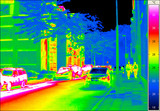Infrared camera provides a better view
Infrared cameras see more than the naked eye and can make road traffic safer. Cameras for the long-wave infrared range, however, have the disadvantage that the sensor requires constant cooling, which adds to the cost and complexity of the device. Now a new type of detector has been developed which functions at room temperature.
At night on an unlit country road: the bends in the road restrict the view ahead and, to make things worse, it is foggy. The car driver is exercising all due care and yet still does not see the deer on the road ahead until it is nearly too late. An emergency stop prevents a collision with the animal just in time. In such situations infrared cameras could provide a better level of safety. Objects at roughly body temperature are luminous in the infrared region at a wavelength of around ten micrometers. Detectors in the camera register this thermal radiation and locate the source of heat. This could enable drivers to see people or animals long before they come into vision through dipped headlights. Other road users would not be inconvenienced by the invisible infrared radiation.
The problem is that infrared cameras for the wavelength range above five micrometers like it cold – the sensor has to be constantly cooled down to about minus 193 degrees Celsius. Uncooled imagers for the long-wave infrared range do already exist today, but they are mainly used in the military sphere and are more or less unavailable on the European market. This is now set to change. Research scientists at the Fraunhofer Institute for Microelectronic Circuits and Systems IMS in Duisburg have succeeded in producing an imaging sensor for the long-wave infrared range that functions at room temperature. »We could be the first in Germany to offer this technology«, says Dr. Dirk Weiler, scientist at the IMS.
At the heart of the IRFPA (Infrared Focal Plane Array) sensor is a microbolometer – a temperature-sensitive detector that absorbs long-wave infrared light. To produce a two-dimensional image, several microbolometers are combined to form an array. If the microbolometer absorbs light from a heat source, its interior temperature rises and its electrical resistance changes. A readout chip then converts this resistance value directly into a digital signal. Previously this was not possible without a further intermediate step – normally the electrical pulse is first translated into an analog signal and then digitized using an analog/digital converter. »We use a very specific type of converter, a sigma-delta converter, in our imager. This has enabled us to produce a digital signal directly«, Weiler explains.
As complex and costly cooling is no longer required, further areas of application become feasible beyond the automotive sector. »Mobile devices in particular should benefit from the new development«, states Weiler confidently. The fact that the cooling mechanism is no longer needed not only saves weight. The battery power available and therefore the operating time of the mobile device increase because no energy is needed for cooling. The potential uses of mobile infrared cameras include firefighting, where they could detect hidden hotspots or locate people in smoke-filled buildings.
Initial laboratory tests with the new sensor element were successful. The research scientists have already been able to produce a number of infrared images.
Download:
Contact:
Dipl.-Ing. Martin van Ackeren
Telefon: +49 203-3783-130
Email: martin.van.ackeren(at)ims.fraunhofer.de
Fraunhofer-Institut für Mikroelektronische Schaltungen und Systeme IMS
Finkenstraße 61
47057 Duisburg
